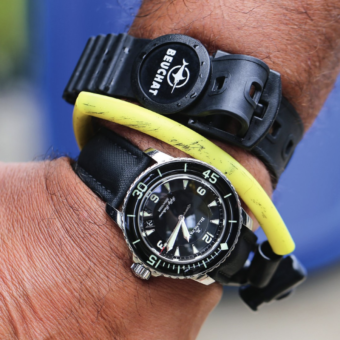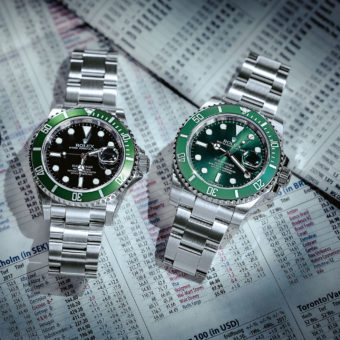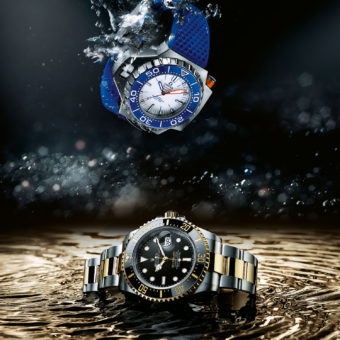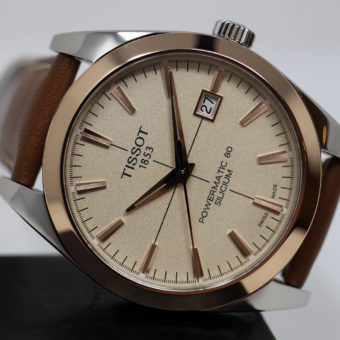
You’ve got about a month to get to that summer reading that you promised yourself you would do. If you are in the mood for a whale of a watch tale, here are five books guaranteed to please.
![]()

1. “Revolution in Time” by David S. Landes, The Belknap Press of Harvard University Press
For watch lovers, “Revolution in Time” is a must read. Landes, an acclaimed historian and professor of economics at Harvard University, is author of a number of important books on technology and industry. In “Revolution,” published in 1983, he examines what he calls a “seminal” event: “The invention of the mechanical clock in medieval Europe…was one of the great inventions in the history of mankind…. One can think of few objects that have played so critical a role in shaping the character of life and work as clocks and watches.”
“Revolution” is a tour de force, magnificent in its scope. Landes tells the story of clocks and watches from Su Sung’s astronomical clock made in China in 1086 to the quartz watch revolution of the 1970s. Along the way, he mixes cultural history, the history of science and technology, and social and economic history with good stories galore. The book is extremely well written. Landes has a reporter’s eye for detail and a writer’s story-telling skills. It is also prodigiously researched. Even Landes’s footnotes – all 76 pages of them – contain delicious tidbits.
Because of the book’s encyclopedic detail, I often return to it to check out one fact or another. Over the years I’ve come to a greater appreciation of the fact that the author is not only a brilliant scholar, but a watch lover. In the “Preface” Landes admits that in researching the book in the 1970s, he caught the watch bug.
“I was smitten – caught by the combination of mechanical ingenuity, craftsmanship, artistry and elegance….I could not get over the talent and time that must have gone into the making of these objects – the devotion that expressed itself in painstaking finish, even in normally invisible details.”
Mechanical watches are fascinating and beautiful, we know. Landes teaches us that they are also important. His book is as fascinating, beautiful and important as the watches he writes about.


2. “Breguet, Watchmakers Since 1775” by Emmanuel Breguet, Alain de Gourcuff Editeur
The extraordinary powers of Abraham-Louis Breguet is the theme of Emmanuel Breguet’s book, published in 1997 on the occasion of the 150th anniversary of Breguet’s birth. Emmanuel is a direct descendant of Abraham-Louis. Though not a watchmaker, he has made a great contribution to watchmaking. He has given us the first detailed biography of the man considered by many the world’s greatest watchmaker. Anyone who thinks that watchmakers are dull sorts inclined to escape into their little micro-world will be astonished by the exploits of Monsieur Breguet. His genius as a watchmaker and watch designer is well known. That he was also an inventor, scientist, politician, political refugee, entrepreneur, and master watch marketer is less well known. He accomplished all this in one of history’s most turbulent times and places – late 18th / early 19th century Paris. Breguet’s story has all the elements of a Victor Hugo novel: personal tragedy (in the space of one year, Breguet’s 28-year-old wife and two children die; he never remarries), political upheaval (the French Revolution), daring escapes (he flees for his life to Switzerland), years in exile, and scandal (Breguet’s son falls in love and fathers a child by the wife of one of his best customers; the lady divorces her husband and becomes Breguet’s daughter-in-law). It’s all bolstered by a constant parade of historical figures (Russia’s Czar Alexander I, the Bonaparte family, Talleyrand, and the Duke of Wellington are among the scores of historical figures whom Breguet knew personally), and, of course, historic watches.
A historian by training, Emmanuel Breguet had access to Breguet company archives and private letters belonging to the Breguet family. He unearths much new material and does an excellent job of placing Abraham-Louis and his achievements in the context of his turbulent times. Breguet deserves to be better known. One example: The Larousse Biographical Dictionary lists 20,000 of the world’s most famous people. Many of them are obscure today. Breguet, despite his watch achievements, his membership in the French Academy, his role in French culture as evidenced by references to his watches in the works of Hugo, Balzac, Stendhal, Dumas, Mérimée, as well as foreigners like Pushkin and Tolstoy, does not make the Larousse list. Emmanuel Breguet’s ancestor finally gets the attention he deserves in this excellent book.


3. “The Best of Time: Rolex Wristwatches, an Unauthorized History,” by James M. Dowling and Jeffrey P. Hess, Schiffer Publishing
How Rolex became the world’s most famous luxury watch is the subject of this 1996 book, written by two watch aficionados, Briton James Dowling and American Jeffrey P. Hess. (These days Hess is the head of Ball Watch USA; he also has other watch businesses.) The is a a large format, 392-page book loaded with photos of Rolex watches and, more importantly, with impressive research on one of the world’s most important, interesting and secretive watch companies.
The authors call it an “unauthorized” history because, as they explain, they “received no help in any way from Rolex or any of its associated companies or any serving employee. Although many ex-employees have been of inestimable help.” The two worked on the book for more than three years.
Rolex was founded by Hans Wilsdorf in London’s Hatton Garden in 1905. In the course of 24 chapters, Dowling and Hess tell the firm’s story well. They keep the narrative moving with information about Rolex people, products, marketing, finances and lore, setting it all in a historical context. They display an impressive eye for detail, and provide a wealth of heretofore unavailable information.
The story’s protagonist and hero is Wilsdorf. He was, the authors point out, ever the outsider. He was born in 1881 to a Protestant family in Germany’s Catholic-dominated Bavaria. At 12, tragedy struck when both his parents died within months of each other. He was sent to a boarding school. As a teenager, he moved to Switzerland to work first for a Geneva pearl firm, then a watch company. At 22, he left Switzerland for London, taking a position with a watch firm. With a British friend, Alfred James Davis, he formed Wilsdorf & Davis in 1905. They registered the name Rolex three years later. It became the corporate name during World War I when anything German-sounding became taboo in Britain. The name of the royal family, Saxe-Coburg-Gotha, became Windsor. German shepherd dogs became Alsatians. And Wilsdorf & Davis became Rolex.
Wilsdorf was a brilliant innovator and promoter. He was an early advocate of wristwatches and embraced all manner of new techniques for making and marketing them, including sports marketing. When a London secretary named Mercedes Gleitze swam across the English Channel in 1927, Wilsdorf made sure she had a Rolex Oyster on her wrist. He heavily promoted the achievement of Gleitze and the Oyster, which kept ticking throughout the swim.
Dowling and Hess chronicle the overall development of the firm and its individual watches. The Oyster, Prince, Datejust, Explorer, Submariner, Kew “A,” GMT Master and President are covered in individual chapters.


4. “Longitude: The True Story of a Lone Genius Who Solved the Greatest Scientific Problem of His Time,” by Dava Sobel, Walker and Company
“Longitude,” published in 1995, heaped well-deserved fame on its author, a former New York Times science writer, and its subject, the 18th-century British watchmaker John Harrison. The germ of this enchanting little book (the text in the original small hardback edition runs for 175 pages) came when Sobel covered a symposium on longitude for Harvard’s alumni magazine. There she happened upon the amazing story of John Harrison and his H-4 watch, “often hailed,” Sobel writes, “as the most important timekeeper ever built.”
The “lone genius” of the book’s subtitle is Harrison. “The greatest scientific problem of his time” is the inability of scientists to measure longitude. Sobel’s superb story-telling skills tell the remarkable tale of how a lowly carpenter-turned-watchmaker solved the longitude problem and won the greatest scientific prize of all time, the 20,000 pounds the British Parliament offered whomever could solve the problem. That’s about $12 million in today’s money. The story has a grand cast of heroes and villains, lots of plot twists and turns, and cameo appearances by a bevy of famous British watch names (Mudge, Graham, Arnold, Earnshaw and more). It is hard to believe that the story of the development of the marine chronometer could be absolutely fascinating. In Dava Sobel’s hands, it is.


5. “Time For America, Hamilton Watch 1892-1992,” by Don Sauers, Sutter House
If you had to pick one brand whose story best tells the tale of American watchmaking, it would have to be Hamilton. (The other contender among brands still active in America would be Bulova, but, alas, there is no history of Bulova.) Don Sauers’s history of Hamilton, “Time For America” was published on the occasion of Hamilton’s centennial in 1992. Sauers does an excellent job of pointing out Hamilton’s importance in watch history and even American history.
Hamilton was founded in Lancaster, PA, by a small group of local businessmen. It first found fame as a maker of railroad watches. Sauers chronicles the firm’s quick rise to prominence. In World War I, General Pershing wore a Hamilton. After the war, Admiral Richard E. Byrd used Hamilton watches to navigate his historic flight over the South Pole. He also used them on later expeditions to the North Pole and Antarctica.
Sauers spends a fair amount of time describing how the company grew and how it operated. Hamilton is, he writes, “a story of the way American factory life used to be – in the days before robots and MBAs.” For a general reader, there may be too much detail about Hamilton’s production, marketing and distribution strategies over the decades. Others, though, will be fascinated by this window into how the watch business worked and how dramatically it changed after World War II.
On the product side, Hamilton was responsible for a number of famous watch firsts. “Hamilton was a pioneer in technical innovation as well as in the mass production of quality watches and clocks,” Sauers writes. “It may surprise some import-conscious Americans to learn that Hamilton, not the Swiss, created the first electric watch, and that Hamilton, not the Japanese, produced the first solid-state digital watch.” The watch was the famous Hamilton Pulsar of 1972.
Hamilton became a Swiss company in 1974 when it was acquired by what is today the Swatch Group. Here, too Hamilton reflected the changing times. Today, Hamilton watches are made in Switzerland. But the brand remains an American icon. “Time For America” explains why.






